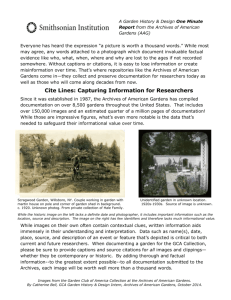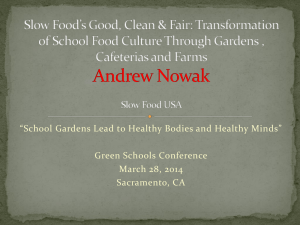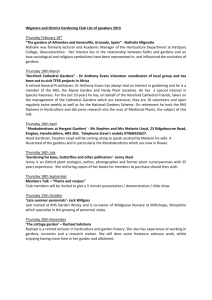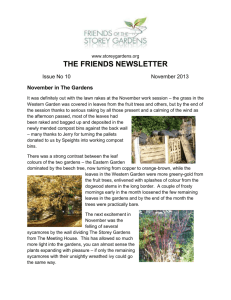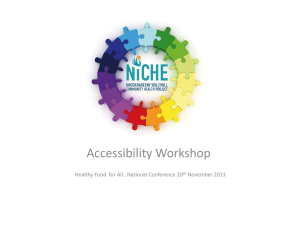Treasures in the Garden - The Tour
advertisement
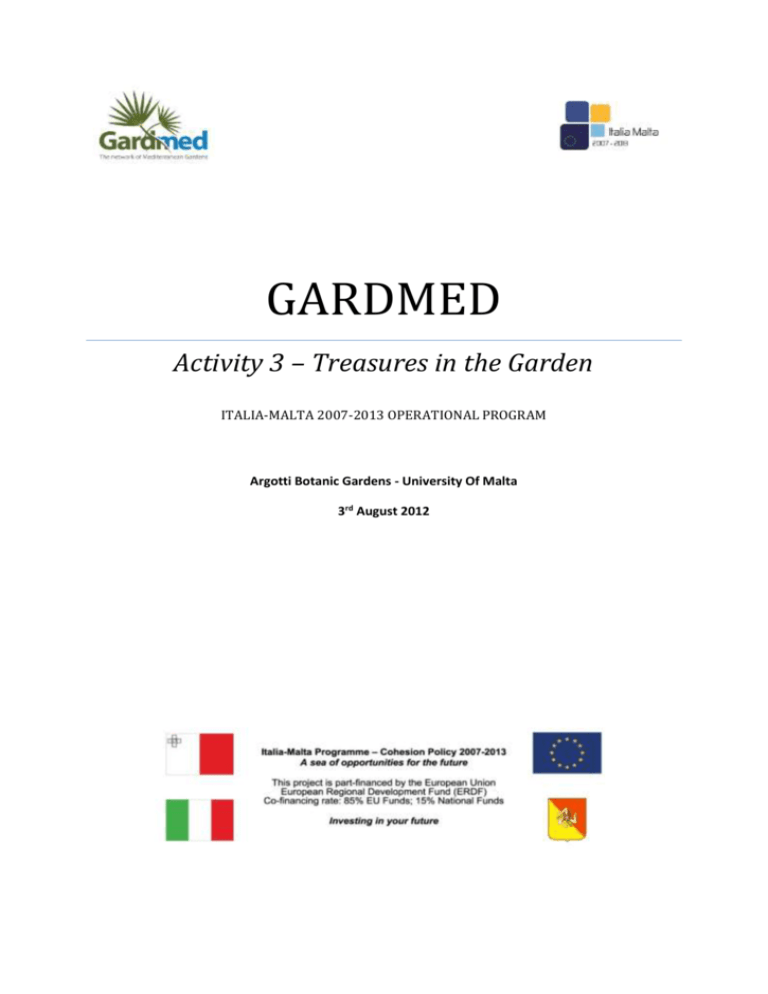
GARDMED Activity 3 – Treasures in the Garden ITALIA-MALTA 2007-2013 OPERATIONAL PROGRAM Argotti Botanic Gardens - University Of Malta 3rd August 2012 GARDMED – Activity 3 Report Treasures in the Garden GARDMED under Italia-Malta 2007-2013 Operational Programme aims to conserve the natural and cultural patrimony as well as highlight and promote garden assets through the establishment of a network of Mediterranean gardens currently incorporating gardens from Malta and Sicily. GARDMED is funded by the European Regional Development Fund and has four partners: University of Catania, Argotti Botanical Gardens (University of Malta), Floriana Local Council and the Municipality of Syracuse. Brief Overview The general public has been invited to take part in five (5) themed activities to be held at Argotti Botanical Gardens and other participating gardens as part of the GARDMED project under ItaliaMalta 2007-2013. The participating gardens are: Villa Bologna, Palazzo Parisio, Luqa Briffa (TalKmand) Garden Żejtun and The President’s Kitchen Garden. The third activity with the theme ‘Treasures in the Garden’ on Friday 3rd August 2012 was held at Argotti Botanic Gardens (University of Malta Section) in Floriana. Guided tours and hands-on activities were held between 9am and 12pm. Advertisement The activities were advertised in both Maltese and English in various local newspapers respectively (The Sunday Times, il-Mument, it-Torċa) on 24 June 2012. The artworks for the adverts are found in Annexe I attached. The adverts were also uploaded on GARDMED Facebook page (https://www.facebook.com/#!/pages/Gardmed/258102884261818 ). The latter adverts also directed the general public to a link with further information. This may be found in Annexe II Further to the adverts, a newspaper article was also published on 24 June 2012 in The Sunday Times. The newspaper article emphasized the main aims of the project and while it also promoted the activities organized as part of GARDMED project (Kindly refer to Annexe III) Signage Adequate signs, including a roll up and plaque were made for the events. Figure 1 - The roll up banner at the entrance of Argotti Botanic Gardens in Floriana Figure 2 - The plaque at the entrance of Argotti Botanic Gardens - University of Malta Section Treasures in the Garden - The Tour The event ‘Treasures in the garden’ highlighted the various products which can be obtained from plants and their economic importance. Various stations were set up around the garden each with different themes. The first station gave a brief introduction to the tour by portraying various plant products such as cotton with seeds, wood, weaving products, medicinal products, syrups, soaps etc. and their biological and economic importance. Station two focused on the production of cork by plants and explained the development of cork in different parts of the plant and why do plants produce it. Following this, a brief overview on the different types of cork available and its economic importance was made. The third station highlighted the development of fibres in plants and their uses. A collection of fibre plants (bamboo, cotton, Musa sp., and palm) and objects made from weaving were made available for viewing. Further to this, Dracaena draco leaves were made available and its fibre strength tested manually by participants. The subsequent station was centred on medicinal plants and their properties. Station five focused on plant extracts, essential oils and soaps. At this station, participants were given useful tips on how to make creams using Aloe vera, and how to apply and store essential oils. The penultimate station displayed an array of natural dyes which were extracted from fruits and vegetables. This station highlighted the various types of natural dyes and their application on fabrics. An informative brochure (Annexe IVb.) on dye preparation and fibres was given to participants. The tour concluded with station seven which underlined wood formation, different woods and objects made from wood. A brief highlight on paper making from logs was also made. Attendees were also given a bag of seeds and a GARDMED pot with Salvia sp.. Further details on the tour content may be found in Annexe IV a. Figure 3 - (Left) the bag of seeds given to attendees. (Right) pots used for planting which were also given to the participants. Figure 4 - Station 1 Overview of different products from plants (Carob pods and syrup, weaved baskets, cork, shampoo extracts, cotton, wood etc. ) Figure 5 - Station 6 Display showing different types of wood, steps in making paper and objects made from wood Figure 6 - Station 6 Plant Dyes Participation Most of the attendees present also participated in the events previously organised as part of GARDMED. For Activity 3, 21 persons pre-booked the tour but other walk-ins also joined tours during the day. The ages of participants varied from children to pensioners and irrespective of age they all asked interesting questions about plants and their economic importance. Figure 7 - Station 3 Plant Fibres Figure 8 - Station 5 Soaps and Essential Oils Figure 9 - Station 4 Plants and Medicines Figure 10 - Station 6 Plant Dyes, Wood and Paper Annexe I a. Artwork b. Newspaper Advert Scans Annexe II Further Information Page GARDMED – Exploring Garden Treasures GARDMED project under Italia-Malta 2007-2013 Operational Programme, aims to promote and conserve the natural and cultural heritage and highlight garden assets through the establishment of a network of Mediterranean gardens currently incorporating gardens from Malta and Sicily. GARDMED is funded by the European Regional Development Fund and has four partners: University of Catania, Argotti Botanical Gardens (University of Malta), Floriana Local Council and the Municipality of Syracuse. The general public is invited to take part in five (5) themed activities to be held at Argotti Botanical Gardens and other participating gardens as part of the GARDMED project under ItaliaMalta 2007-2013. The participating gardens are: Villa Bologna, Palazzo Parisio, Luqa Briffa (TalKmand) Garden Żejtun and The President’s Kitchen Garden. Further information on the garden which will be open on the day of the activity will be communicated prior to the event. These activities will include guided tours consisting of hands-on activities in the garden. The garden events are scheduled for the following dates: 28th June, 6th July, 3rd and 16th August and 7th September 2012. Activity Number 1 2 3 4 5 Date June 2012 th 6 July 2012 3rd August 2012 16th August 2012 7th September 2012 28th Title of Activity Fascination of Plants From Decorative to Edible Plants Garden Treasures Sustainable Use of Garden Resources Garden and Nature All the tours and activities are free of charge, however due to the limited places available, interested participants should book prior to the event. Group bookings for school children or other entities are also accepted. For further information contact Argotti Botanic Gardens (University of Malta Section), Vincenzo Bugeja Street, Floriana on 21248984 between 8:00am and 12:00pm or email: argottigardens@um.edu.mt Annexe III UNIVERSITY OF MALTA Press release GARDMED – The Network of Mediterranean Gardens GARDMED is a project funded by the European Regional Development Fund under Italia-Malta 2007-2013 Operational Programme which intends to create a network of Mediterranean gardens. The partners currently include the Catania Botanic Gardens (University of Catania), Argotti Botanical Gardens (University of Malta), the Municipality of Syracuse and the Floriana Local Council. The GARDMED network will involve fifteen public and private gardens in Malta and the Southern provinces of Sicily with the aim to promote and conserve the cultural and natural heritage associated with historical Mediterranean gardens. One of the many objectives of the project is to educate the general public on the natural heritage found in the gardens. To this end, a ten-day gardening course commenced on 6th of June 2012 focusing on both theoretical and practical aspects. The course has received a good response with over 20 participants. In addition to the gardening course, garden-related activities are also being organized at Argotti Botanic Gardens (University of Malta) in Floriana. The garden-related events will be held at Argotti and other participating gardens during the summer months from the end of June until the beginning of September 2012. The five activities, which will consist of tours and hands-on activities in the garden, will centre on the following themes: Fascination of Plants, Decorative Plants, Flowers and Food from your Garden, Garden Treasures, Sustainable Use of Garden Resources and Garden and Nature. The general public is being invited to attend these open days organized as part of the GARDMED project at Argotti Botanic Gardens (University of Malta) in Floriana, which are free of charge. Entrance for the activities will be on the hour between 9:00am and 12:00pm. Further information about GARDMED and dates for the activities may be obtained by contacting Argotti Botanic Gardens (University of Malta Section), Vincenzo Bugeja Street, Floriana on 21248984 between 8:00am and 12:00pm, email argottigardens@um.edu.mt or by accessing the link on the University Of Malta website: www.um.edu.mt/argotti/activitiesen Communications & Alumni Relations Office 20 June, 2012 Annexe IV a. From Decorative to Edible Plants – Tour highlights Station 1 – Showing different materials and resources that can be obtained from plants - - Last time we saw how different parts of the plants can be used as fruit, vegetable, herbs or spices for culinary purposes. In today’s tour we will see how different plant parts can be used as raw materials for building, weaving, medicine making, soap making and dye making etc. Here are some examples: o Bast from Hemp (i.e. Qanneb) o Cotton clothing o Wood ornaments o Dye o Paper o Medicine o Cork o Weaved materials o Soaps More details will be given along the tour Station 2 – Cork - - - What is cork? o Cork is made from a substance called suberin o Suberin is impermeable elastic and fire resistant Why does the plant produce cork? o Name suberin layer in the roots – Casparian strip forces solutes to pass from symplast pathway, therefore plants can prevent harmful solutes from entering o In mangroves suberin used to control the amount of alt taken up by plants o In cork oaks it is used to protect from fire How is it harvested? o Using axes o Does not harm tree…takes 9 years to regrow o Plant lives for 150 years so approx. 15 harvests - Cork quality o Porous corks are cheaper since less impermeable but non- porous ones are high quality – 60 cents each o When a wine is said to be corked, it means that mildew grew on the cork. Therefore care must be taken for cork quality Station 3 – Plant fibers - Cotton Hemp Reeds Palms Dracaena sp. Musa textilis used to make rope Linen Nettle yarn Straw hats Station 4 –Plants and Medicine - - - ‐ - Cranberry Juice or Extract o This and related Uva Ursi extract has been shown to inhibit the activity of "adhesin", which is needed for the pili, or tiny hairs, on the E coli bacteria to stick to the cells lining the urinary tract. They may therefore be useful in the treatment and prevention of bladder infections with those bacteria. Garlic o Garlic has been shown to reduce cholesterol about 12% and to reduce platelet adhesiveness (the reason an aspirin a day is recommended to reduce the risk of stroke and heart attack). Salvia o Helps combat effects of Alzheimer’s o Reduces perspiration o Reduces hot flushes during menopause Catharanthus roseus o Vinblastine works by stopping the cancer cells from separating into two new cells. So it blocks the growth of the cancer. Carob Tree and Melissa Officinalis o Combats cough like Melissa Chilli Pepper o Laxative effect - - - Withania somnifera o Withania somnifera is commonly used to treat nervous exhaustion, anxiety, stress, and insomnia. Poppy o Opium is the dried latex obtained from the opium poppy o Morphine is a chemical found up to 25% in opium o Heroin is made by applying a reaction to morphine Aloe vera o Moisturizer o Acne o Sunburn o Eczema o Pesticides o Lower blood sugar in diabetics Station 5 – Plants, Soaps and Oils - Aloe saponaria, rosemary, mint, lavender, citrus o Experiment – removal of biro marks using gel extracted from A. saponaria. Essential oils e.g. lavender and tea tree oil o Uses as antiseptic, relaxation and other medicinal properties o Addition of essential oils to creams o Storage of essential oils Station 6 – Natural Dyes - Extracting dyes from plants Different types of natural dyes o Direct – stain fibers without the aid of other chemicals due the high presence of tannic acid. o Mordant/ Adjective dyes – need assistance to adhere to fabrics. Station 7 - Wood What is wood? - Why is it produced in the plant? Wood is not all the same it varies amongst species and even within the same tree - Different types of wood within the same tree: Show log and explain cork layer, sapwood, heart wood Show different types of wood and trees from which they originate Explain that the final quality of wood depends on : o The molecules it is made of cellulose hemicelluloses lignin o The types of cell structures inside o Pigments in cells o Density How is paper made? - Logs Chopped into kindling Kindling washed and put in boiler at high temperatures to form paste Paste is bleached Water is removed and paste is compressed to form paper b. Information Sheet


